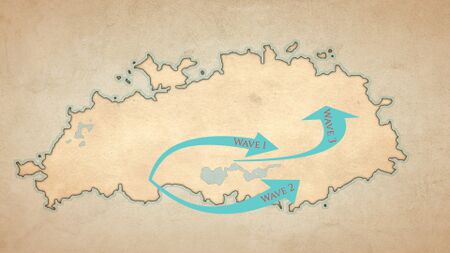Dawn
Dawn is the name given to the three waves of migration from the Western Dantrian civilization to the central and eastern parts of the Continent that happened in the course of several centuries, beginning in the middle of the first revolution. Travelers would cross the arid planes of Nari into what later would become Gantolia and Yammoe, and then venturing further east.
The Dawn is contrasted to the New Dawn, a migration wave from Central Dantria that occurred in the second half of the second revolution across the Ouna desert.
Origin of name
The name "Dawn" first appeared as the reference to the Kingdoms of the Dawn - Tyrna, Troun and Nadd - that were established on the Laeooy Coast (Bukkean: the Dawn Coast). The term "people of the Dawn" began to be applied to explorers of Tarnaria, including by the settlers themselves.
Although the settlement of Tarnaria is the result of the third wave of migration, eventually the whole phenomenon began to be referred to as the Dawn.
Reasons for the migration
Exact reasons for the Dawn are unknown and some of its aspects constitute an anthropological mystery. Specifically, migration resulted in the development of several original languages, religions and cultures which, as far as we know, have little in common with the civilization of Western Dantria.
But in addition to that, these cultures ended up having little in common with one another, while the expectation is that migrants from Western Dantria would have a relatively common cultural background. For instance, Lolion, which was the main religion in Dantria, seemed to be virtually unknown to the Dawn settlers. Instead, Lolion was later exported by monks through Gantolia almost 10 centuries later.
At the same time, the settlers have seemingly exported sophisticated technologies, such as road building and architecture and well developed forms of government. Tarnarian royal ranks are believed to have been based on a system from Dantria, as both Gantolia and Asdoh have independently implemented very similar systems.
In contrast, the migrants of the New Dawn clearly had a common cultural background, spoke a closely related set of Thonthal-like languages and articulated reasons for their migration in a number of writings.
Several explanations are put forward.
The first, articulated first by Mlan, states that there could have been extreme diversity of the population of Dantria, and possibly the coexistence of many languages and religions, although it begs the question of what prompted such different peoples to embark on a dangerous and faraway journey. Hypotheses include famine, war, disease and cultural prosecution, but none of these ideas explain features of the Dawn to full satisfaction. Surviving Dantrian documents, although few, reveal nothing of importance happening at the time of the Dawn. For instance, there is a historical treatise written by an unknown author from Walneer that dates its account to the end of the 16th and the beginning of the 17th CFR. It talks about some of the important events of the previous decades, but none of them feature anything that would prompt a massive migration.
Mlan argues that the violent destruction of the Western Dantrian civilization destroyed the majority of its written history, leaving researchers with very little to work with. At the same time, it took a long time for a more organized life to be established in the east, with significant historians emerging only by the end of the first revolution. This, in turn, was centuries after the beginning of the Dawn and the focus of authors like Porteek and Ludoh was on Tarnaria and its immediate neighbors. Finally, the subsequent emergence of Stogen led to the destruction of written documents in Tarnaria, further shattering the historical record.
Another explanation was suggested by Thalmad, Mlan's student who specialized in the Dawn. Thalmad refers to the earliest known trips around Ouna by Western Dantrian travelers. These roundtrips, known as bfaltonzee in Zamborana Zambonia were an activity that are mentioned in surviving Dantrian historical writings and are thought to be the primary mechanism of populating areas such as Teamatian and some areas north of Ouna long before the Dawn. Thalmad then suggests that the Dawn was itself an instance of a bfaltonzee, but one that involved masses of people, perhaps as the result of some traditional ritual, with many of the participants settling midway.
Three waves of migration
Researchers typically differentiate between three waves of migration. Very early on, historians began to refer to these as first, second and third waves, which is misleading as the waves are not meant to be chronological and instead designate the main migration streams that ended up resulting in very different countries, cultures, languages and religions. In modern sources, the waves are referred to as the Gantolian wave, the Loodorian wave and the Asdohn wave. However, numerical monikers still dominate popular references to the Dawn.
The first wave has populated Gantolia and Yammoe. The second wave resulted in Loodori, and later Ybuwyn. The third wave established the State of Asdoh, Toor and possibly Dlos. The latter is sometimes considered the fourth wave of Dawn.
Chronologically, all three waves were occurring at the same time, with perhaps the second wave beginning around 60 years earlier than the other two.
